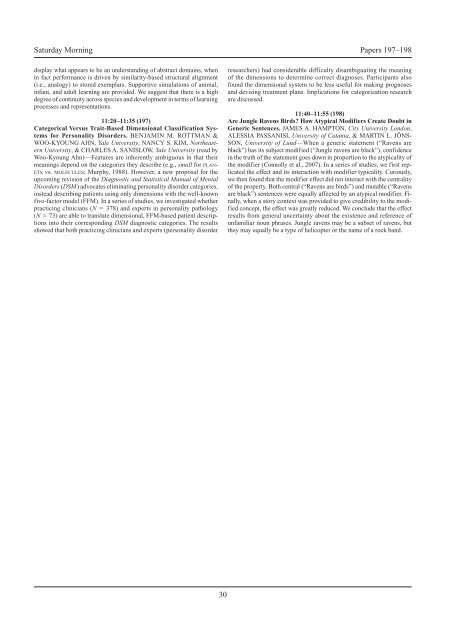Abstracts of the Psychonomic Society — Volume 14 — November ...
Abstracts of the Psychonomic Society — Volume 14 — November ...
Abstracts of the Psychonomic Society — Volume 14 — November ...
Create successful ePaper yourself
Turn your PDF publications into a flip-book with our unique Google optimized e-Paper software.
Saturday Morning Papers 197–198<br />
display what appears to be an understanding <strong>of</strong> abstract domains, when<br />
in fact performance is driven by similarity-based structural alignment<br />
(i.e., analogy) to stored exemplars. Supportive simulations <strong>of</strong> animal,<br />
infant, and adult learning are provided. We suggest that <strong>the</strong>re is a high<br />
degree <strong>of</strong> continuity across species and development in terms <strong>of</strong> learning<br />
processes and representations.<br />
11:20–11:35 (197)<br />
Categorical Versus Trait-Based Dimensional Classification Systems<br />
for Personality Disorders. BENJAMIN M. ROTTMAN &<br />
WOO-KYOUNG AHN, Yale University, NANCY S. KIM, Nor<strong>the</strong>astern<br />
University, & CHARLES A. SANISLOW, Yale University (read by<br />
Woo-Kyoung Ahn)<strong>—</strong>Features are inherently ambiguous in that <strong>the</strong>ir<br />
meanings depend on <strong>the</strong> categories <strong>the</strong>y describe (e.g., small for planets<br />
vs. molecules; Murphy, 1988). However, a new proposal for <strong>the</strong><br />
upcoming revision <strong>of</strong> <strong>the</strong> Diagnostic and Statistical Manual <strong>of</strong> Mental<br />
Disorders (DSM) advocates eliminating personality disorder categories,<br />
instead describing patients using only dimensions with <strong>the</strong> well-known<br />
five-factor model (FFM). In a series <strong>of</strong> studies, we investigated whe<strong>the</strong>r<br />
practicing clinicians (N 5 378) and experts in personality pathology<br />
(N 5 73) are able to translate dimensional, FFM-based patient descriptions<br />
into <strong>the</strong>ir corresponding DSM diagnostic categories. The results<br />
showed that both practicing clinicians and experts (personality disorder<br />
30<br />
researchers) had considerable difficulty disambiguating <strong>the</strong> meaning<br />
<strong>of</strong> <strong>the</strong> dimensions to determine correct diagnoses. Participants also<br />
found <strong>the</strong> dimensional system to be less useful for making prognoses<br />
and devising treatment plans. Implications for categorization research<br />
are discussed.<br />
11:40–11:55 (198)<br />
Are Jungle Ravens Birds? How Atypical Modifiers Create Doubt in<br />
Generic Sentences. JAMES A. HAMPTON, City University London,<br />
ALESSIA PASSANISI, University <strong>of</strong> Catania, & MARTIN L. JÖNS-<br />
SON, University <strong>of</strong> Lund<strong>—</strong>When a generic statement (“Ravens are<br />
black”) has its subject modified (“Jungle ravens are black”), confidence<br />
in <strong>the</strong> truth <strong>of</strong> <strong>the</strong> statement goes down in proportion to <strong>the</strong> atypicality <strong>of</strong><br />
<strong>the</strong> modifier (Connolly et al., 2007). In a series <strong>of</strong> studies, we first replicated<br />
<strong>the</strong> effect and its interaction with modifier typicality. Curiously,<br />
we <strong>the</strong>n found that <strong>the</strong> modifier effect did not interact with <strong>the</strong> centrality<br />
<strong>of</strong> <strong>the</strong> property. Both central (“Ravens are birds”) and mutable (“Ravens<br />
are black”) sentences were equally affected by an atypical modifier. Finally,<br />
when a story context was provided to give credibility to <strong>the</strong> modified<br />
concept, <strong>the</strong> effect was greatly reduced. We conclude that <strong>the</strong> effect<br />
results from general uncertainty about <strong>the</strong> existence and reference <strong>of</strong><br />
unfamiliar noun phrases. Jungle ravens may be a subset <strong>of</strong> ravens, but<br />
<strong>the</strong>y may equally be a type <strong>of</strong> helicopter or <strong>the</strong> name <strong>of</strong> a rock band.





